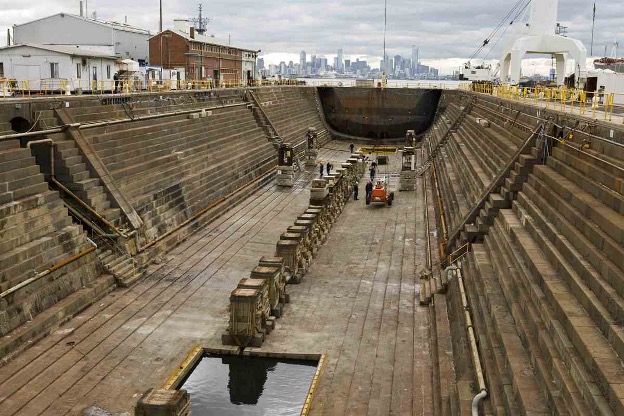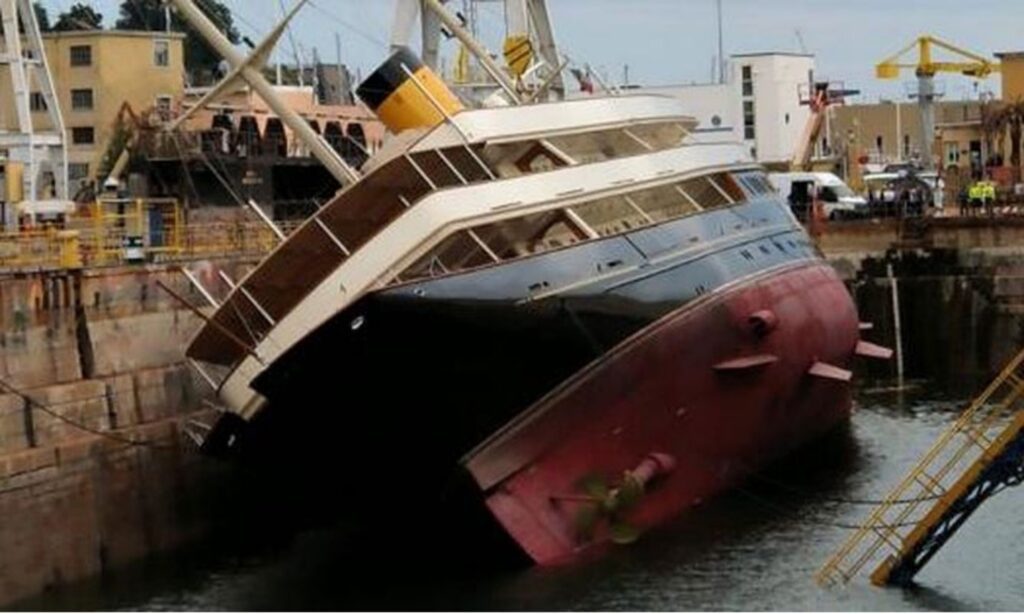The efficiency of a ship is determined by how well all the ship’s machinery and operating systems are maintained. To ensure such conditions are maintained, SOLAS Chapter-I Regulation-10, stipulates that all active ships in the 100A5 category must undergo a bottom survey twice every 5 years.
In addition, merchant vessels older than 15 years must also be inspected for breaches or defaults twice every five years with the period for passenger ships being every two years.
A Dry Dock’s primary goal is to perform effective repairs and maintenance on ship parts that are constantly in contact with marine water and therefore are not visible unless the water is flushed out.
Drydocking is the process of removing a ship from the water to enable work to be performed on the exterior part of the ship below the waterline.

Subjecting vessels to this process is a requirement if the Classification Society determines that Dry Docking is necessary, despite SOLAS schedules.
Given that dry docking is one of the most frequently used methods for the repair and maintenance of ships, it is a critical knowledge required of maritime professionals. This article explains the complete procedure for dry docking and the scope of repairs that can be carried out during dry docking.
What is Drydocking?
A ship is said to be “dry docked” when it is brought into a dry dock and positioned on a set of blocks that are stacked on the dry dock’s bottom and are referred to as “keel blocks” because they are placed under the ship’s keel.
In order to prevent the ship’s hull plating from making direct contact with steel, which could lead to plate damage, the keel blocks are made of steel with wooden tops that could be adjusted to align with the taper of the keel member they are to support.
The primary goal of dry docking is to expose and inspect the parts of the vessel that have been submerged for an extended period of time. These submerged sections require regular inspection because they sustain damage from seawater, and because the ship is so large, dry docking is the only efficient way to maintain it.
There are about 4 known different types of Dry-Docking techniques, the Graving dock, the floating dock, the syncrolift system, and the slipway system of which the Floating and the Graving Docks are the most common.
Graving/ Excavated Dock.
The graving or excavated dock is built on land near the seashore with concrete walls, blocks, and gates. This is the most basic docking technique, in which the ship is maneuvered inside the dock and rests on blocks that are placed on the bottom of the docks.
These blocks are aligned to the shape of the ship’s bottom and when the ship has sat on the blocks, the dock gates are closed and water is pumped out of the docks.
Floating Dock.
Floating docks are specifically designed for the repair of vessels that have been involved in accidents or have broken down in the middle of the sea. Pontoons, which are U-shaped structures, are used to recover ships from the sea.
These U-shaped structures are filled with water, causing the dock to sink and assisting the ship to sail into the dock. Once the ship has been secured into the dock, the water is pumped out causing the dock to rise and exposing parts of the ship that would otherwise be underwater.

Syncrolift / Shiplift Dock.
A shiplift docking method, also known as a syncrolift, is used for ships weighing 800 to 25000 tons. Whereas a floating dock makes use of the buoyant force of the pontoon, in the Syncrolift system, the ship is transferred onto a platform placed on the bed of the graving dock, and both ship and platform are heaved up on the land by winches installed on either side of the platform.
Slipway, patent slip.
The Slipway method is designed specifically for smaller boats. In this system, the hull is mounted on trolleys and pulled ashore on the incline using winches.
Another form of slipway docking method is called a “marine railway,” in which a boat is dragged onto a cradle that stretches from the coast to the water on an inclined plane. This method is typically employed when larger ships with a ship weight of roughly 3000 tons need to be repaired.
How is a Ship Prepared for Drydocking?
Planning a ship’s dry docking needs a significant amount of effort and attention to detail. This can roughly be broken up into 4 phases: Pre-docking phase, preparation of docking plan, stability verification, and the actual docking to put the ship on the dock blocks.
Pre-docking Phase
During the pre-docking phase, planning will take place. When the ship is scheduled to arrive for dry docking, the dock master will create a docking plan. This plan accounts for every conceivable aspect of the vessel, down to the structure of the hull, the positioning of the echo sounders, and the drain plugs. These specifics are important to ensure that the ship does not sustain any harm as a result of the docking operation.
Preparation of Docking Plan.
In the process of preparing the dock plan, the dock master and the designers make use of sketches and perform in-depth calculations about the height, weight, and structure of the ship. Because the docking plan specifies how to effectively dock and undock the vessel while minimizing the possibility of the ship capsizing, all of these specifics are included in the document.
Verification of Stability Conditions
It is extremely important to ensure that the ship is stable before docking. To accomplish this, it is necessary to determine how the ship’s weight is distributed over its keel blocks, which bear the greater part of the load because any mistake in the calculations could result in an accident.
The critical period is at the time when the keel first touches the block until the vessel takes blocks overall. There is a virtual loss of stability at this time. It is therefore essential to understand the stability condition prior to the beginning of the process itself.
When the ship arrives at the dry-docking port, it is essential to maintain the required stability conditions in order to avoid being delayed in the repair process.
It is imperative that the vessel’s propeller be submerged, and it should have the minimum amount of ballast possible. After these tests have been completed, the dock master and cleaners will board the ship.
The Docking.
Once all of the pre-docking requirements have been satisfied, the ship is guided into the dock, where it is then tied and secured. The next step is to begin the cleaning processes, which include removing the drain plugs, operating the ballast pump, and pumping away the dock water.

Are There Any Risks Associated with Drydocking?
Drydocking is an activity that is required in the ship’s operation process and has a direct impact on the ship’s technical condition. However, this operation may be hazardous and is associated with a high level of risk occurrence. This is due to improper docking preparation of ships as well as errors committed during the operation itself.
Make no mistake: working on a dry dock is a dangerous job. Every year, workers are injured in and around dry docks all over the world. Degassing, welding, and other potentially flammable activities are common in dry docks, where airflow is already restricted. These circumstances can lead to fires, explosions, and even toxic exposure.
While the vessel is out of the water, both the vessel and the dry dock are on a tight schedule. The rapid pace can exacerbate already hazardous conditions such as the presence of large machinery, slippery surfaces, electrical shock, and cramped quarters.
During dry dock, there is also a steady flow of people, equipment, goods, and cargo being loaded and unloaded. A single blunder can spell disaster. And a lack of safety equipment could quickly turn a bad situation into a disaster.
Even if the job is hazardous, there is no excuse for workplace negligence. Workers should be given the necessary training and equipment, including safety equipment.
They should only be asked to work around machinery and equipment that is routinely inspected, repaired as needed, and subject to preventative maintenance. Workspaces should be kept neat and tidy, with no tripping hazards.
Conclusion.
Dry Docking is an essential procedure that needs to be efficiently carried out. To safeguard the interest of ship owners and the drydock company during ship dry docking procedures, efficient drydock management is of high significance
Failure to provide any of the above may expose drydock workers as well as shipboard personnel to unnecessary risk and personal injury.
- Sustainable and Luxurious: Discovering Split’s Yachting Paradise – April 26, 2024
- MarineTraffic vs VesselFinder: Which Is Better Vessel Tracking Service? – February 14, 2024
- Port Costs: A Comprehensive Guide to Port Dues and Fees for Cargo Ships – February 12, 2024






Leave a Reply